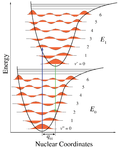Ionization energy
Ionization energy (IE), also known as ionization potential, is the energy required to remove an electron from a neutral atom or molecule in the gaseous state. It is a fundamental property of atoms and molecules that has significant implications in chemistry, physics, and materials science. The ionization energy is measured in electron volts (eV) or kilojoules per mole (kJ/mol).
Overview[edit]
The concept of ionization energy is crucial in the study of atomic and molecular structures. It provides insights into the reactivity and chemical behavior of elements. The first ionization energy refers to the energy needed to remove the first electron from an atom, while the second ionization energy is the energy required to remove the second electron, and so on. Generally, the ionization energy increases as more electrons are removed, due to the increasing positive charge of the ion which more strongly attracts the remaining electrons.
Factors Affecting Ionization Energy[edit]
Several factors influence the ionization energy of an atom or molecule:
- Atomic Number: As the atomic number increases, the ionization energy generally increases because the electrons are held more tightly by the nucleus due to the greater nuclear charge.
- Electron Configuration: Atoms with a stable electron configuration (such as noble gases) have higher ionization energies because their electrons are more difficult to remove.
- Atomic Radius: Generally, the larger the atomic radius, the lower the ionization energy, because the outer electrons are further from the nucleus and are less strongly attracted to it.
- Shielding Effect: Inner electrons can shield outer electrons from the full charge of the nucleus, reducing the ionization energy for those outer electrons.
Periodic Trends[edit]
Ionization energy exhibits distinct trends within the Periodic Table:
- Across a Period: Ionization energy generally increases across a period from left to right. This is due to the increase in nuclear charge, which more strongly attracts electrons.
- Down a Group: Ionization energy generally decreases down a group. As the atomic radius increases, outer electrons are further from the nucleus and are more easily removed.
Applications[edit]
Ionization energy has various applications in different fields:
- In Chemistry, it helps in predicting the reactivity of elements and the formation of chemical bonds.
- In Physics, it is essential in the study of spectra and quantum mechanics.
- In Materials Science, understanding ionization energies is important for designing and characterizing new materials with specific electronic properties.
Measurement[edit]
Ionization energies are typically measured using techniques such as photoelectron spectroscopy, where photons are used to eject electrons from atoms or molecules, and the kinetic energy of the ejected electrons is analyzed.
See Also[edit]
References[edit]
<references/>
-
Ionization energy
-
Ionization energy
-
Ionization energy
-
Ionization energy
-
Ionization energy
-
Ionization energy
-
Ionization energy
-
Ionization energy
-
Ionization energy
-
Ionization energy
Ad. Transform your life with W8MD's Budget GLP-1 injections from $75


W8MD offers a medical weight loss program to lose weight in Philadelphia. Our physician-supervised medical weight loss provides:
- Weight loss injections in NYC (generic and brand names):
- Zepbound / Mounjaro, Wegovy / Ozempic, Saxenda
- Most insurances accepted or discounted self-pay rates. We will obtain insurance prior authorizations if needed.
- Generic GLP1 weight loss injections from $75 for the starting dose.
- Also offer prescription weight loss medications including Phentermine, Qsymia, Diethylpropion, Contrave etc.
NYC weight loss doctor appointmentsNYC weight loss doctor appointments
Start your NYC weight loss journey today at our NYC medical weight loss and Philadelphia medical weight loss clinics.
- Call 718-946-5500 to lose weight in NYC or for medical weight loss in Philadelphia 215-676-2334.
- Tags:NYC medical weight loss, Philadelphia lose weight Zepbound NYC, Budget GLP1 weight loss injections, Wegovy Philadelphia, Wegovy NYC, Philadelphia medical weight loss, Brookly weight loss and Wegovy NYC
|
WikiMD's Wellness Encyclopedia |
| Let Food Be Thy Medicine Medicine Thy Food - Hippocrates |
Medical Disclaimer: WikiMD is not a substitute for professional medical advice. The information on WikiMD is provided as an information resource only, may be incorrect, outdated or misleading, and is not to be used or relied on for any diagnostic or treatment purposes. Please consult your health care provider before making any healthcare decisions or for guidance about a specific medical condition. WikiMD expressly disclaims responsibility, and shall have no liability, for any damages, loss, injury, or liability whatsoever suffered as a result of your reliance on the information contained in this site. By visiting this site you agree to the foregoing terms and conditions, which may from time to time be changed or supplemented by WikiMD. If you do not agree to the foregoing terms and conditions, you should not enter or use this site. See full disclaimer.
Credits:Most images are courtesy of Wikimedia commons, and templates, categories Wikipedia, licensed under CC BY SA or similar.
Translate this page: - East Asian
中文,
日本,
한국어,
South Asian
हिन्दी,
தமிழ்,
తెలుగు,
Urdu,
ಕನ್ನಡ,
Southeast Asian
Indonesian,
Vietnamese,
Thai,
မြန်မာဘာသာ,
বাংলা
European
español,
Deutsch,
français,
Greek,
português do Brasil,
polski,
română,
русский,
Nederlands,
norsk,
svenska,
suomi,
Italian
Middle Eastern & African
عربى,
Turkish,
Persian,
Hebrew,
Afrikaans,
isiZulu,
Kiswahili,
Other
Bulgarian,
Hungarian,
Czech,
Swedish,
മലയാളം,
मराठी,
ਪੰਜਾਬੀ,
ગુજરાતી,
Portuguese,
Ukrainian




